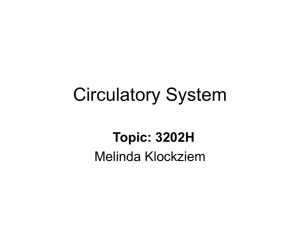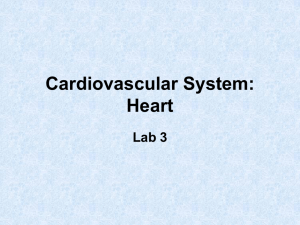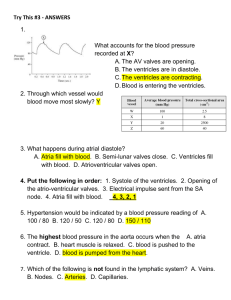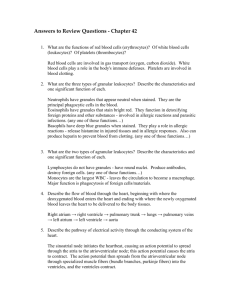The Cardiovascular System
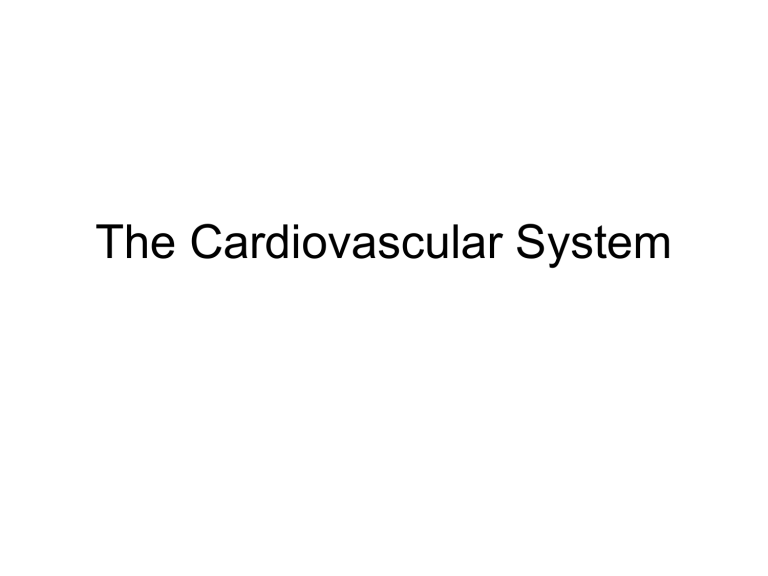
The Cardiovascular System
The Cardiovascular System
• A closed system of the heart and blood vessels
– The heart pumps blood
– Blood vessels allow blood to circulate to all parts of the body
• The function of the cardiovascular system is to deliver oxygen and nutrients and to remove carbon dioxide and other waste products
The Heart
• Location
– Thorax between the lungs in the inferior mediastinum
• Orientation
– Pointed apex directed toward left hip
– Base points toward right shoulder
• About the size of your fist
The Heart
Figure 11.1a
–b
The Heart
The Heart
Figure 11.2a
The Heart: Coverings
• Pericardium—a double-walled sac
– Fibrous pericardium is loose and superficial
– Serous membrane is deep to the fibrous pericardium and composed of two layers
• Visceral pericardium
– Next to heart; also known as the epicardium
• Parietal pericardium
– Outside layer that lines the inner surface of the fibrous pericardium
– Serous fluid fills the space between the layers of pericardium
The Heart: Heart Wall
Figure 11.2b
The Heart: Heart Wall
• Three layers
– Epicardium
• Outside layer
• This layer is the visceral pericardium
• Connective tissue layer
– Myocardium
• Middle layer
• Mostly cardiac muscle
– Endocardium
• Inner layer
• Endothelium
The Heart: Heart Wall
Figure 11.2b
The Heart: Heart Wall
Figure 11.2c
The Heart: Chambers
• Right and left side act as separate pumps
• Four chambers
– Atria
• Receiving chambers
– Right atrium
– Left atrium
– Ventricles
• Discharging chambers
– Right ventricle
– Left ventricle
The Heart: Chambers
Figure 11.2c
Differences in Right and Left
Ventricles
Figure 11.4
The Heart: Septa
• Interventricular septum
– Separates the two ventricles
• Interatrial septum
– Separates the two atria
The Heart: Chambers
Figure 11.2c
The Heart: Valves
• Allow blood to flow in only one direction to prevent backflow
• Four valves
– Atrioventricular (AV) valves—between atria and ventricles
• Bicuspid (mitral) valve (left side of heart)
• Tricuspid valve (right side of heart)
– Semilunar valves—between ventricle and artery
• Pulmonary semilunar valve
• Aortic semilunar valve
The Heart: Valves
Figure 11.2c
The Heart: Valves
• AV valves
– Anchored in place by chordae tendineae (“heart strings”)
– Open during heart relaxation and closed during ventricular contraction
• Semilunar valves
– Closed during heart relaxation but open during ventricular contraction
• Notice these valves operate opposite of one another to force a one-way path of blood through the heart
Operation of the AV valves
Blood returning to the atria, puts pressure against
AV valves; the AV valves are forced open
As the ventricles fill, AV valve flaps hang limply into ventricles
Atria contract, forcing additional blood into ventricles
(a)
Ventricles
AV valves open
Figure 11.5a, step 3
(a)
Ventricles contract, forcing blood against AV valve flaps
AV valves close
Chordae tendineae tighten, preventing valve flaps from everting into atria
AV valves closed
Figure 11.5a, step 6
Aorta
Pulmonary trunk
Operation of the semilunar valves
As ventricles contract and intraventricular pressure rises, blood is pushed up against semilunar valves, forcing them open
Semilunar valve open
(b)
As ventricles relax, and intraventricular pressure falls, blood flows back from arteries, filling the leaflets of semilunar valves and forcing them to close
Semilunar valve closed
Figure 11.5b, step 2
Systemic and Pulmonary
Circulations
• Systemic circulation
– Blood flows from the left side of the heart through the body tissues and back to the right side of the heart
• Pulmonary circulation
– Blood flows from the right side of the heart to the lungs and back to the left side of the heart
Systemic and Pulmonary
Circulations
Figure 11.3
The Heart: Associated Great
Vessels
• Arteries
– Aorta
• Leaves left ventricle
– Pulmonary arteries
• Leave right ventricle
The Heart: Associated Great
Vessels
• Veins
– Superior and inferior venae cavae
• Enter right atrium
– Pulmonary veins (four)
• Enter left atrium
The Heart: Associated Great
Vessels
Blood Flow Through the Heart
• Superior and inferior venae cavae dump blood into the right atrium
• From right atrium, through the tricuspid valve, blood travels to the right ventricle
• From the right ventricle, blood leaves the heart as it passes through the pulmonary semilunar valve into the pulmonary trunk
• Pulmonary trunk splits into right and left pulmonary arteries that carry blood to the lungs
Blood Flow Through the Heart
• Oxygen is picked up and carbon dioxide is dropped off by blood in the lungs
• Oxygen-rich blood returns to the heart through the four pulmonary veins
• Blood enters the left atrium and travels through the bicuspid valve into the left ventricle
• From the left ventricle, blood leaves the heart via the aortic semilunar valve and aorta
Coronary Circulation
• Blood in the heart chambers does not nourish the myocardium
• The heart has its own nourishing circulatory system consisting of
– Coronary arteries—branch from the aorta to supply the heart muscle with oxygenated blood
– Cardiac veins—drain the myocardium of blood
– Coronary sinus—a large vein on the posterior of the heart, receives blood from cardiac veins
• Blood empties into the right atrium via the coronary sinus
The Heart: Conduction System
• Intrinsic conduction system (nodal system)
– Heart muscle cells contract, without nerve impulses, in a regular, continuous way
The Heart: Conduction System
• Special tissue sets the pace
• Sinoatrial node = SA node (“pacemaker”), is in the right atrium
• Atrioventricular node = AV node, is at the junction of the atria and ventricles
• Atrioventricular bundle = AV bundle (bundle of
His), is in the interventricular septum
• Bundle branches are in the interventricular septum
• Purkinje fibers spread within the ventricle wall muscles
Heart Contractions
Figure 11.6
Heart Contractions
• Contraction is initiated by the sinoatrial node (SA node)
• Sequential stimulation occurs at other autorhythmic cells
• Force cardiac muscle depolarization in one direction —from atria to ventricles
Heart Contractions
• Once SA node starts the heartbeat
– Impulse spreads to the AV node
– Then the atria contract
• At the AV node, the impulse passes through the AV bundle, bundle branches, and Purkinje fibers
• Blood is ejected from the ventricles to the aorta and pulmonary trunk as the ventricles contract
Heart Contractions
Figure 11.6
Heart Contractions
• Tachycardia—rapid heart rate over 100 beats per minute
• Bradycardia—slow heart rate less than 60 beats per minutes
The Heart: Cardiac Cycle
• Atria contract simultaneously
• Atria relax, then ventricles contract
• Systole = contraction
• Diastole = relaxation
Filling Heart Chambers: Cardiac
Cycle
Left atrium
Right atrium
Left ventricle
Right ventricle
Ventricular filling
Atrial contraction
Isovolumetric contraction phase
Ventricular ejection phase
Isovolumetric relaxation
Mid-to-late diastole
(ventricular filling)
Ventricular systole
(atria in diastole)
Early diastole
Figure 11.7
The Heart: Cardiac Cycle
• Cardiac cycle—events of one complete heart beat
– Mid-to-late diastole—blood flows from atria into ventricles
– Ventricular systole—blood pressure builds before ventricle contracts, pushing out blood
– Early diastole—atria finish refilling, ventricular pressure is low
